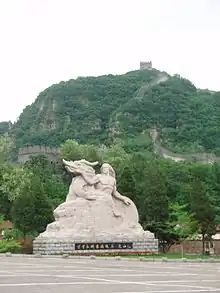

The Liaodong Garrison (simplified Chinese: 辽东镇; traditional Chinese: 遼東鎮; pinyin: Liáodōngzhèn) was one of the Nine Garrisons established by the Ming dynasty to defend the northern border and the Great Wall.
The area of responsibility was to defend the eastern section of the Great Wall in Liaoning, which extended from the Shanhai Pass on the Bohai Bay to the Hushan Wall in Dandong on the Yalu River, along the Chinese border with North Korea. This garrison area encompassed a total of 975 km of the wall. The Liaodong Garrison was under the command of the supreme commander of Jiliao[1] and was headquartered in Liaoyang.
The Great Wall in the Liaodong Garrison was the first to be built during the Ming dynasty. Its western part was built to protect China from the Mongols, while the eastern part served as protection against the Manchus (Jurchen). The middle part of the Liaodong Garrison Wall, along the Liao River, was constructed during the reign of the Yongle Emperor (r. 1402–1424). The western part was completed during the first reign of Emperor Yingzong (1435–1449), and the eastern part was completed by the Chenghua Emperor (r. 1464–1487).[2] The wall was constructed using a variety of materials, including 490 km of packed earth, 140 km of stone, and 85 km of wood. The remaining sections were made up of natural barriers, such as mountains.[2] However, today, very little of the Great Wall remains in Liaoning. It was not until 1989 that the ruins of the Hushan Wall, located in the farthest east, were discovered.
Many historical texts fail to mention the Liaodong Garrison Wall, and instead incorrectly attribute the Shanhai Pass as the eastern end of the Ming Great Wall. This is because the Qing dynasty, who did not want to acknowledge the role of the Liaodong Wall in protecting China against the Manchus, purposely omitted it from their records.[2]
To the west, the Liaodong Garrison bordered the Jizhou Garrison.[2]